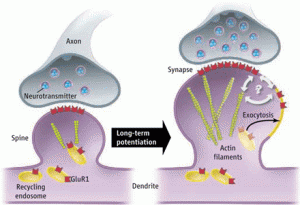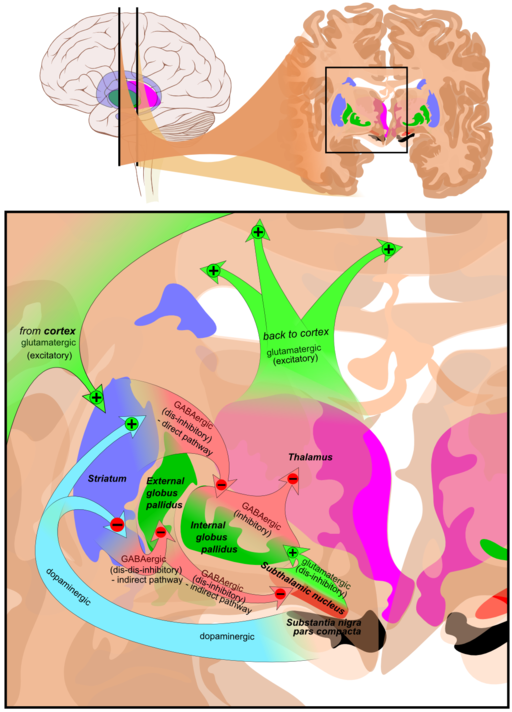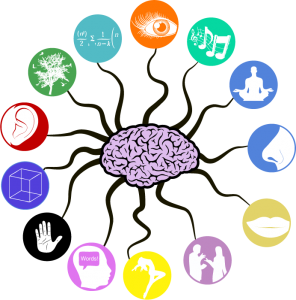 Learning and memory depend upon neuroplasticity in the connections of brain circuits. Recent studies show much greater complexity in neuroplasticity than just changes occuring in single synapses. Rather, changes appear to occur in large distributed networks throughout the brain. Because of the widespread multi sensory integration in the human brain, learning occurs when diverse brain capacities in many parts of a brain circuit are strengthened through neuroplasticity. In fact, this may be the only way we learn. The important interrelationships of neuroplasticity learning and brain circuits are just being discovered.
Learning and memory depend upon neuroplasticity in the connections of brain circuits. Recent studies show much greater complexity in neuroplasticity than just changes occuring in single synapses. Rather, changes appear to occur in large distributed networks throughout the brain. Because of the widespread multi sensory integration in the human brain, learning occurs when diverse brain capacities in many parts of a brain circuit are strengthened through neuroplasticity. In fact, this may be the only way we learn. The important interrelationships of neuroplasticity learning and brain circuits are just being discovered.
The brain changes its function when needed, reorganizing regions when nerves are severed. In just two hours after being blindfolded, extra touch signals are transmitted through visual brain centers. Eventually entire regions of visual function switch to other functions–blind people use the visual cortex for hearing, and the deaf lip-read much better than others. The brain seeks to gather useful information with its neurons, changing the function when needed by neuroplasticity. Neurons actively alter their neurotransmitters with changing circumstances. Recent studies shows a constant sculpting of the synapses each night by microglia active in building and pruning synapses.
Neurons and brains appear to gather information from any source possible using neuroplasticity to change the function. What is the mechanism of a cell searching for more, and different, information?
Complexity of Neuroplasticity
 Learning has been considered a process that can strengthen or weaken individual synapses, through long-term potentiation and depression. Recently, the detailed molecular structures that occur in synapses have been found to be extremely complex with thousands of interlocking proteins maintaining the extra cellular space between neurons. The synapse also includes thousands of interlocking proteins building extremely complex structures such as the postsynaptic density (the PSD structure has yet to be exactly determined and is different in many different neurons and species). Microtubules and other cytoskeletal elements are a very important part of the active scaffolding changes for the building, pruning and strengthening of the synapse on a minute to minute basis.
Learning has been considered a process that can strengthen or weaken individual synapses, through long-term potentiation and depression. Recently, the detailed molecular structures that occur in synapses have been found to be extremely complex with thousands of interlocking proteins maintaining the extra cellular space between neurons. The synapse also includes thousands of interlocking proteins building extremely complex structures such as the postsynaptic density (the PSD structure has yet to be exactly determined and is different in many different neurons and species). Microtubules and other cytoskeletal elements are a very important part of the active scaffolding changes for the building, pruning and strengthening of the synapse on a minute to minute basis.
But, the real complexity is now becoming clearer. In fact, there are many different types of neuroplasticity changes that occur even in a single synapse. There are a vast array of different chemicals, signaling systems, and factors that affect these changes. Please see my previous post How Neuroplasticity Works for a detailed discussion of some of the complexity in the dendrite buds, the cytoskeleton, and the distributed network. Calcium channels are one important factor, as are the multiple levels of RNA signaling and DNA factors. There are also electrical types of neuroplasticity with changes in the membrane ion channels. All of these occur in coordinated ways at the same time, or in an organized sequence.
Neuroplasticity Not in One Synapse, But Throughout A Circuit
But, even more significant is the very recent finding that the synaptic changes are not occurring in one place, but rather throughout all the connecting neurons in the brain circuit. These synaptic changes can occur simultaneously or can be temporally orchestrated in varied sequences. Multiple mechanisms work on the entire circuit in different ways, strengthening or weakening subsets of the connections of the circuit.

One example is the coordination of movement memory, which includes many different kinds of neuroplasticity changes in multiple brain regions in the cortex, the hippocampus and the cerebellum, all at the same time. For habit motor learning all of these types of cells must change in many cerebellar layers simultaneously. In another region changes occur in sequence, first in the granule cells, then Purkinje cells, and then interneuron cells (see post). Another type of neuroplasticity in this cerebellar memory involves cycles of changes between the climbing fibers and the mossy fibers. After these changes occur, then alterations occur in a wide variety of other networks connected to the cerebellum in different regions of the brain change at the same time.
The important point thus far is that neuroplasticity changes as learning occurs simultaneously in many places at once and with many different mechanisms and different sequences. How this can occur without central direction is not at all clear. Somehow, the individual synapses all know that a circuit is being imprinted with neuroplasticity changes, perhaps through back and forth communication.
Also, it has not been clear how the hard wired axon/dendrite synaptic connections relate to other types of information in the form of synchronous brain waves that are used for communication from one part of the brain to another. An interesting derivative of this new distributed form of neuroplasticity is that once the circuit has become more substantial with added scaffolding, electrical channels, and elaborate molecular changes, these new structures in the circuit might benefit regions by allowing synchronous brain waves to link different regions of the circuit.
Multi Sensory Brain
The synergy of these two newly discovered brain processes – distributed neuroplasticity and multi sensory or multi modality brain function – are critical to enhanced learning.
 Since each sense is useful in different circumstances, it is very beneficial to have multiple different senses operating at once. Using all sources at once, there is much greater chance of interpreting important information coming from the outside, which has obvious evolutionary advantages. It is, therefore, not surprising that our oldest ancestors, individual microbe cells, are masters of using multiple inputs at once. Previous posts on microbes have shown that single cells search for information and can make decisions based on chemical contact with the cell, pressure or sound, light, acidity and turbulence (see post). Based on multiple factors they carry on important communication with other microbes (post) and other species (post).
Since each sense is useful in different circumstances, it is very beneficial to have multiple different senses operating at once. Using all sources at once, there is much greater chance of interpreting important information coming from the outside, which has obvious evolutionary advantages. It is, therefore, not surprising that our oldest ancestors, individual microbe cells, are masters of using multiple inputs at once. Previous posts on microbes have shown that single cells search for information and can make decisions based on chemical contact with the cell, pressure or sound, light, acidity and turbulence (see post). Based on multiple factors they carry on important communication with other microbes (post) and other species (post).
In fact it is this multi sensory ability of individual cells that has allowed the development of individual brain cells that can respond to multiple different inputs, all impinging on one neuron.
Current accepted functional categories of brain regions were established a generation ago, with areas for individual senses and then areas of integration, called association regions. As with many generation-old theories, in fields where most of the information has been discovered in the past few years, it is almost impossible, today, to define single sense regions and association regions. In fact, studies show that between 10% to 50% of the neurons in supposedly single sensory regions have neurons that are receiving inputs from multiple sensory modalities at once. Recent MRI studies have shown multisensory regions in all small lobules of the cortex. This is in direct conflict with the accepted notion of brain structure.
Another important point is that current “modular” theories of brain evolution might be incorrect. The neuronal hubs in each part of the brain that appear to have a primary focus, such as hearing or memory, are assumed by the modular theory to have mostly local connections and few long-range connections, with other associational areas combining the regions. But, the recent studies of Sporne, who coined the phrase “connectome,” find that this is not case. Each brain hub has a large amount of local connections, but also a very large amount of long-range connections as well. Therefore, each modular hub has multi integration connections as if it is the central hub.
There is no evidence of a central hub, or a central body map (homunculus), which presents a great difficulty in explaining unified subjective experience. Distributed neuroplasticity might be one way it could possibly be explained.
Everyday Examples of Multi Sensory Brain
There are many examples of the way the brain uses multiple senses rather than one. One example is that smells, sights and sounds can change the taste of a food. If an orange drink is colored red people think it tastes like cherry.
 Another is that hearing speech usually involves visually observing the lips of speakers. In fact speech is ascertained in the brain by hearing centers, visual centers, and touch. When Helen Keller touched peoples lips, cheeks and necks she could understand their speech in the same language centers by touch.
Another is that hearing speech usually involves visually observing the lips of speakers. In fact speech is ascertained in the brain by hearing centers, visual centers, and touch. When Helen Keller touched peoples lips, cheeks and necks she could understand their speech in the same language centers by touch.
Other examples include taste altered by sounds, and posture influenced by vision. If someone is observing a waterfall and has their hand on a table, there is a sensation that the table is moving upward.
There are many more examples of the multi sensory brain in all aspects of life.
The Power of Multi Modalities in the Brain for Learning
Two experiments show how distributed neuroplasticity and multi sensory, multi modal brain structures relate to learning.
Learning and Neuroplasticity Experiment 1. Visualization of High Jumping
 High jumpers preparing for a meet use visualizations of high jumping in order to prepare for the jump. They go through the entire event in their mind.
High jumpers preparing for a meet use visualizations of high jumping in order to prepare for the jump. They go through the entire event in their mind.
With visualizing the high jump performance is improved by 35%
More remarkably, when the same experiment was done visualizing the high jump PLUS an added motion of the arms during the visualization of the jump, the improvement was 45%.
Using visualization PLUS a motor movement increased the learning and the effect – increasing the neuroplasticity in multiple regions of the brain rather than just one. This shows that learning with multi brain modalities increases the learning by increasing the range and strength of the circuit involved in the neuroplasticity. Basically, it solidifies a wider brain structure.
Learning and Neuroplasticity Experiment 2. Gesturing While Teaching
A class was taught mathematics and a certain percentage learned the material well.
 The second part of the experiment occurred when exactly the same material was taught, but there was an added hand motion during the lesson. Gestures were made during the lesson such as pointing to the two sides of an equation, one side with one hand and the other side with the other hand.
The second part of the experiment occurred when exactly the same material was taught, but there was an added hand motion during the lesson. Gestures were made during the lesson such as pointing to the two sides of an equation, one side with one hand and the other side with the other hand.
Again, with the math lesson PLUS hand gestures the learning was greatly improved.
When multiple brain modalities are used there is greater neuroplasticity and greater learning.
 There are many other examples of these findings. One involves learning and perception while a rhythm is played with an emphasized beat, such as the first of three beats in a waltz. If the learning or perception testing is done on the emphasized beat, the learning or perception is much greater than on the other beats, or without rhythm.
There are many other examples of these findings. One involves learning and perception while a rhythm is played with an emphasized beat, such as the first of three beats in a waltz. If the learning or perception testing is done on the emphasized beat, the learning or perception is much greater than on the other beats, or without rhythm.
Other examples include melodic singing training where using hand motions increases learning.
These all appear to show that the basic process of neuroplasticity is enhanced when a larger range of brain functions are utilized. The molecular strengthening that occurs in the synapses throughout the circuit produces stronger learning.
Multi Modal Brain

Music, and exercise both appear to function in unique ways in the brain. Both are very multi modal events and both are highly correlated with increased learning. Many studies have shown that exercise has a wide range of positive effects on the brain and increases memory and learning. Music also has been shown to utilize a large amount of the brain at the same time and enhances learning. Examples of this include using the effects of rhythmic music to alleviate severe movement disorders such as Parkinson’s disease.
In both cases, the amount of neuroplasticity learning ability is increased not just in the specific tasks but also in other unrelated aspects of learning. This super neuroplasticity is called metaplasticity and appears also to be related to the multi modal effects of neuroplasticity.
The best learning is that which pulls together the most active regions and solidifies the circuit with neuroplasticity changes. It makes sense that neuroplasticity wouldn’t occur in one synapse because complex behavior occurs in multiple places in the brain at once.
Two Examples of the Power of Multi Modal Neuroplasticity
Both music events and spiritual practices provide examples of multi modal neuroplasticity and both are known to evoke powerful memories and often life changing experiences.
Musical Event, Distributed Neuroplasticity, and Multiple Brain Modalities
How can a musical event evoke powerful experiences, which are experienced by many of us?
 Let us trace the brain elements in a musical event that would increase learning and impact.
Let us trace the brain elements in a musical event that would increase learning and impact.
- Melody, lyrics, and the meaning of the words each involve multiple different parts of the brain.
- The unique effects of rhythm in learning and therapies have been discussed in previous posts. The rhythm effects are connected to many parts of the brain in the lyrics, beat of the music and the physical movement of dancing.
- Feelings related to performers, the history of the band and individual members of the band connect limbic regions to all the other factors.
- Strong affective associations with particular songs have addictive qualities, where people listen to the songs for decrease in anxiety, for stimulation, and for creativity. The strong feelings, constant repetition, and mental associations stimulate the powerful nucleus accumbens addictive brain regions.
- Dancing utilizes powerful gestures emphasizing every aspect of the event, just as the gestures in teaching algebra and planning for high jumping did; but dancing gestures are much more powerful because of the emotional content. These gestures emphasize the lyrics, the meaning of the words of the song, the melody, relations to the performers and the social context, and personal memories.
- Social relations are a powerful force involving limbic brain regions. Memories and associations of people who are present, as well as those who are not have strong effects.
If all of these brain regions form a circuit with strengthening neuroplasticity, the experience, the learning and the memories can be extremely powerful and life changing. These many brain properties are all embedded in the enlarging circuit that has a vast effect on changes in a large amount of the brain.
Spiritual Practice, Distributed Neuroplasticity, and Multiple Brain Modalities
 Another example is meditation where a variety of important brain functions are involved in a process of neuroplasticity.
Another example is meditation where a variety of important brain functions are involved in a process of neuroplasticity.
- Meditation practice might include listening to sounds, a religious phrase, a prayer or mantra. The meaning of the phrase is related to other brain regions. Associations of this sound to previous memories triggers another brain region.
- Rhythm effects are present here also, both in the mantra, and in breathing and heart beat.
- Visualization is involved with a spiritual picture or image, a light such as a candle or the sun, a teacher, or a natural scene.
- Physical movement occurs with observing the breath or heart beat, which become more prominent the deeper and quieter the meditation. Relaxing each set of muscles includes a wide range of brain centers as does sitting in a straight but relaxed pose.
- If physical hatha yoga postures are added to this, many other motor brain regions become involved, including position and reflex senses for all muscles, joints, and tendons.
With concentration all of these brain regions build a powerful multi modal brain circuit.
Gospel Experience
In a gospel service, the elements of the meditation are added to the elements of the performance producing powerful experiences. These experiences can be so powerful that no practice is necessary, just immersion. The melody, prayer, rhythm, meaning, bodily movements, clapping, shouting, dancing are all intermingled in one very strong, complex brain circuit that can bring about life changing experiences with added health benefits.
In these two examples, the multiple brain circuits used are vast and span the entire brain.
Conclusion
Somehow, the brain at a deep level coordinates multiple neuroplasticity mechanisms in multiple places and times all at once without a central mechanism. Neuroplasticity occurs in brain circuits, not just single synapses. Brain centers with large amounts of local neural connections also have large numbers of long range connections, making each region a central hub. With no one central hub each region is filled with multi sensory and multi modality connections. When circuits, connecting widespread regions, are strengthened does this become a platform for other forms of long range neuronal signaling, such as with synchronous waves between different centers in the circuit?
This coordination from many directions and at many different rates without a clear center is reminiscent of the complexity of the genome. It is also similar to the search for the locations in the brain that are correlated with consciousness. In research into consciousness, there are always many different regions working together without apparent direction from any one region. But, it appears that the more coordinated the whole brain becomes, the more widespread is the neuroplasticity, the more powerful is the learning and the more cogent are the experiences.
Is there a way that the mind is the central mechanism stimulating these large integrating processes?